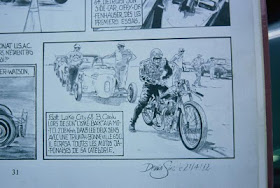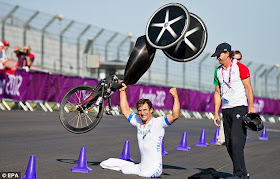It's been a tiring month or two here at bikewriter.com's sprawling corporate campus, and I have posted very little.
I've got some excuses, of course. (If I've learned anything in the last decade in the U.S., it's that nothing is anyone's fault.) I'm just putting the finishing touches on two books that I want to have available for Christmas, and I finally finished a long promised screenplay for a sci-fi short. Meanwhile, I'm occasionally distracted by several other film projects that are 'in development' as they say. That's movie-business talk for 'looking for money'.
It's not that there hasn't been lots to write about in motorcycle land. The other shoe finally dropped vis-a-vis Laguna Seca losing its MotoGP round; the fact that Dani Pedrosa's Honda was rendered immediately and utterly unrideable after Marc Marquez made incidental contact that disabled the traction control system. Don't get me started on Casey 'Whingebag' Stoner -- who won the championship because he was the first rider to completely trust traction control -- saying he'd return if the bikes made even more power and had no TC.
That rogue gang of stuntahz and the Range Rover guy -- I'd write about them, but everyone else already has. My scooter got stolen -- and I caught the guy but haven't yet recovered the scoot -- there's a whole real-life cops-and-robbers story there. And then there was the guy (another cop!) who sent
a press release to Roadracing World, announcing that he was going to start a business in which hot nurses would rehydrate and re-oxygenate club-level motorcycle racers... Well, that one is so crazy that maybe I
will revisit it in the coming days.
 |
| This guy walks into a motel office. As he's paying for the room, he says to the clerk, "I hope the porn channel's disabled." The clerk says, "No, it's regular porn, you sick fuck." |
Anyway, last night, I found myself fondly hearkening back to the days when I worked at
Motorcyclist, and spent two or three nights a week in L.A. Fond thoughts about that period of my life aren't common, because with a couple of exceptions, I worked for/with psychopaths and L.A. is one of the world's biggest urban failures. The one good thing -- besides the free motorcycles and OEM-paid travel to exotic destinations like Willow Springs -- about working in L.A. was, it was the only place I've ever lived that had a good place to grab a beer on Monday night.
I don't know what it is about me, but I seem to be inclined to work out, work, stay home and cook; I do boring shit all weekend and never really feel like going out. Then come Monday, I find myself thinking, "I've gotta' get out and do something." Yesterday was one of those Mondays. I actually went the whole day without having a single face-to-face conversation of any kind with another human. But last night, when I would have gone out somewhere, I realized that on a Monday night in Kansas City, there was probably nowhere to kill an hour amongst entertaining strangers.
That wasn't the case when I worked at
Motorcyclist. At least not after I found out about
that bar.
I have no idea what the bar was called. It was in NoHo -- a neighborhood that actually should'a been called "lotsa' hos" -- and if the bar had a name, it wasn't posted anywhere. It had a street number, and a very large man at the door. And Mondays, it rocked. The place was packed.
It was not for Monday Night Football. Nope. It was packed because the clientele were sex trade workers, and if you're a hooker, Monday is your Saturday.
That un-named bar wasn't the only place I encountered hookers on my
Motorcyclist beat.
While I worked in L.A., I lived in San Diego. So my commute, door-to-door was 120 miles. I typically worked one or two days per week on assignment, one or two days per week from home, and a couple of days per week in the Petersen Building on Wilshire Boulevard. My office window looked north across Hollywood; if the smog was not too bad, the sign was visible on the hills. But if you looked
south from my floor, you were surveying a vista where, on any given night, someone was being murdered.
Since living in San Diego was
my problem, the magazine had no interest in subsidizing my accommodation for a night or two in L.A. And since I was making shit money, I had to find a cheap motel.
There were a couple of candidate hostelries commensurate with my rather stringent budgetary constraints. They were fucking dives yes, south of my office.
The one I settled on was $40 a night.
In central L.A.
Use your imagination.
Go worse; go way worse. The building presented some gay coral-hued stucco facade to the street. To enter the motel, you drove (or in my case, rode) through a sort of portico into an inner "court". I'm using that word very, very loosely. A square of motel rooms, each presenting a single window and door into the court, were numbered from about 1 to 20. They were usually dark, but when a new vehicle entered, there was often a rustle at a few curtains.
In the corner, there was a lighted window, and a sign: Office.
The owners were Chinese, or of that descent anyway. Food smells, and Chinese soap opera soundtracks wafted from the heavy wrought-iron window grille. A crude sign blared the message:
No drugs!
No prostitutes!
Beneath it, there were rates for a week, a night,
and an hour. The first time I paid for a room, they actually let me use a credit card. On all subsequent visits they screeched, "Machine broken! Cash only".
You've gotta' understand; at the time, I was riding motorcycles from Motorcyclist's press fleet. It was a selective filter for machines on the sublime-to-ridiculous spectrum. I'd show up on a different new bike ever time; a Ducati 99-whatever it was in 2004, a new Gixxer 1000; once I showed up on a Honda Rune and another time on what was probably the only Rocket III in the country. The manufacturers who'd loaned us those bikes would've shit themselves if they realized where I was leaving them overnight. Although in truth, it wasn't that dangerous; the owners let me park the bikes right by their window. It was open all night, and there was always someone in there watching TV. It would've taken a pretty brazen thief, and it wasn't a place anyone casing high end bikes would ever have entered looking for a high end bike.
Typically, what I'd do is get my room, and walk a block to the nearest 7-11. I'd buy a bag of chips, a beer, a bottle of OJ, and a banana, and walk back to the dump. There was a side-entrance into the courtyard, from that direction. Before going to sleep, I'd drink the beer, eat the chips, and watch whatever passed for TV. It wasn't like they had a full satellite package; it was more like rabbit ears. The next morning I'd get up, eat the banana, drink the juice, and try to shower and dry off without getting some nasty foot fungus, then hightail it to Starbucks.
The thing was, those motorcycles made me cool in there. Hookers love bikes. Well, there was that time I arrived on a brand new Ducati and one girl, after admiring it, went next door to get another girl to come and see it.
"You should see this guy's crotch rocket," she said.
Her friend came out, took one look and said, "Oh. I thought it was going to be a Ninja."
Kawasaki were getting good money out of their Ricky Gadson sponsorship, I guess.
Most of those chicks were pretty hardened, desperate crackheads. (I think it was still crack back then; when I found drug paraphernalia in the room, which happened fairly often, it was usually a crack pipe. But maybe they used the same type of pipe for meth. Whatever.)
Some of the girls, however, were sweet and sad. They were occasionally funny. Once they came to grips with the fact that I was not in the market but didn't hate them, either, we struck up little two-minute friendships.
There was one that I saw often enough that I got to know her name -- though I've long since forgotten it. I recall it being something rural and anachronistic, like Beulah. I'll call her that, anyway, for the rest of this story.
Anyway, one night I was walking back from the 7-11 with my goodie bag, and noticed two things: First, there was a hooker standing out on the street by the main entrance, and she was white. That never happened. Second, there was a tough looking white dude standing mostly out of sight at the corner of the building, near the side entrance. The guy gave me a real what-are-
you-looking-at staredown as I approached, and I knew immediately he was a cop. I also knew he had nothing on me and my story checked out, so I gave it back to him.
In the courtyard, Beulah hissed "psst" from a doorway, and whispered that the white girl on the sidewalk was a cop. She said it like she was really worried I might try to tap that thing. I told her, Sweetie, if anybody in here ever gets my money, it'll be you.
That made her smile.
I didn't think much more of it until, at about two o'clock in the morning, there was an enormous fucking ruckus right on the other side of a wall that was probably just wallpaper laid right on 2x4s, with no drywall or anything.
"Police!"
"Freeze!!"
"You're under arrest!!!"
It turned out the female cop was bringing johns back to a room right next to mine. And that happened again at about three o'clock, and four. The fucking LAPD didn't even have the decency to buy the rooms on either side of their sting room. I don't know what saps ever hired that white "hooker"; she and her minder couldn't have looked more like cops if they'd been wearing their uniforms (which, come to think of it, would probably have
attracted business up in NoHo, where there was a much kinkier vibe.)
They must've ruined Beulah's business that night. They ruined my night's sleep, that's for sure. My only consolation was that the asshole who'd given my stinkeye never got the satisfaction of cuffing me. And that early the next morning, they were probably watching from some window as I rode out on some brand-new bitchin' bike, looking suspicious as hell.

















